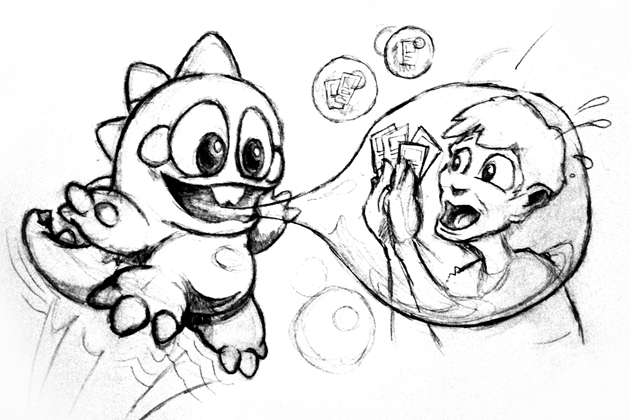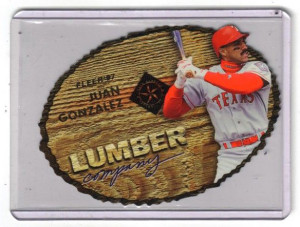 As a kid, I really liked baseball. I also really liked the idea of getting rich quick.
As a kid, I really liked baseball. I also really liked the idea of getting rich quick.
That’s why I own thousands of baseball cards.
For kids who liked baseball in the 90s, baseball cards were basically penny stocks packaged with terrible bubble gum. We told ourselves that we collected cards because we loved the sport, but really, we were all dreaming of trading in that Ken Griffey Jr. rookie card for $50 and retiring.
Because without the promise of fast cash, baseball cards are pretty lame. Can you imagine trying to get a kid excited about baseball cards today?
“Hey Hunter, you like baseball, right?”
“Yeah! Well, only when I get to bat.”
“OK, well you know how we went to that baseball game last summer?”
“I remember getting water because the pop was too expensive. I also remember the play place, but it wasn’t as good as that one at the big McDonald’s. We left early because you were really worried about the traffic.”
“Remember the players on the field?”
“Yeah, they were in that cool video on the big screen at the beginning.”
“Right! Now imagine if your favorite player…you have a favorite player right?”
“No.”
“OK, well imagine if you had a favorite player, and his video on the big screen paused on the best part. Like him hitting a home run or something. Now that picture is on a piece of cardboard! Is that something you would be interested in?”
“A picture of someone else batting?”
“Right!”
“Is that it?”
“Oh, right, there are also statistics on the back!!”
I have no idea how even one child has ever bought a baseball card.
But I know that it must have happened, because I have boxes and binders full of them. I tried to never touch these cards, sincenicking the edges could drop them from mint condition to near-mint and ruin all their value. When we got our first computer, I fired up Windows 3.1 and put Excel to good use by documenting my best cards.
The very best ones got lifted from the blue binder to be protected by hard, plastic display cases. The most valuable card I ever pulled was a 1997 Fleer Juan Gonzalez Lumber Company insert card. It looked like a cross section of a log. It was fantastic.
It was worth $12.
The reason I know this is because I subscribed to a Beckett Magazine. If you are unfamiliar with this publication, 90% of the magazine looked like a phone book with card names and values. I was a child who not only collected cardboard, but also subscribed to a phone book.
I was a child who not only collected cardboard, but also subscribed to a phone book.
Each month, I’d carefully pore through the magazine to learn which cards had gone up or down in value. The 1994 Donruss Mark McGwire went up from $.40 to $.65? Excellent.
What I didn’t realize when I was a kid was that the baseball card industry during the 1990s was basically 1917 Russia. Companies were printing so many cards that I’d need a wheelbarrow full of them to buy a loaf of bread.
Even today, those cards are worthless. I just looked up a few sets I know I have on freebaseballcardspriceguide.com (Beckett Magazine is another phone book that lost to the Internet). The most expensive card in the 1995 Topps set is a $1.50 Derek Jeter. The 1991 Fleer set tops out at $.55 for a Barry Bonds/Ken Griffey Jr. combo card. You can even snag my prized Juan Gonzalez Lumber Company insert for $2.75 on eBay right now.
The most expensive card I could find was a 1993 Triple Play card featuring President Bill Clinton throwing out the first pitch. It’s currently $3.34.
At the same time I was collecting baseball cards, I was also playing Nintendo. I got an original Nintendo Entertainment System for my sixth birthday, and I spent many a summer day on it with my brother, trying to beat Water World together on Super Mario Brothers 3 and blowing each other up in Bomberman 2.
I still have the old Nintendo in my house because I have so many great memories with it. My brother just bought one and asked for a few of his favorite games for his birthday.
When I tried to buy them on eBay, I was shocked by what I found.
If I tripled my baseball card collection, I couldn’t equal that one copy of Bomberman 2.
I looked up some more.
Mega Man 2: $25
Mega Man 6: $50
Chip ‘n Dale Rescue Rangers 2: $150
Then I remembered he specifically mentioned Bubble Bobble 2. We had a lot of fun with that one, but I don’t remember it being super popular. Surely I could find Bubble Bobble 2 for a good price.
LIFE LESSON #21
When you waste time trying to get rich, you miss some pretty valuable things.




